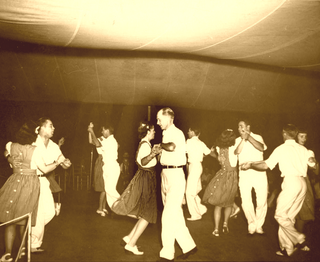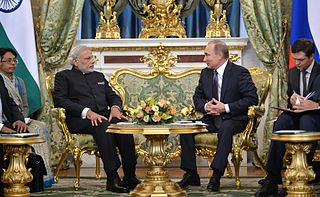
Contra dance is a form of folk dancing made up of long lines of couples. It has mixed origins from English country dance, Scottish country dance, and French dance styles in the 17th century. Sometimes described as New England folk dance or Appalachian folk dance, contra dances can be found around the world, but are most common in the United States, Canada, and other Anglophone countries.

Black tie is a semi-formal Western dress code for evening events, originating in British and American conventions for attire in the 19th century. In British English, the dress code is often referred to synecdochically by its principal element for men, the dinner suit or dinner jacket. In American English the equivalent term tuxedo is common. The dinner suit is a black, midnight blue or white two- or three-piece suit, distinguished by satin or grosgrain jacket lapels and similar stripes along the outseam of the trousers. It is worn with a white dress shirt with standing or turndown collar and link cuffs, a black bow tie, typically an evening waistcoat or a cummerbund, and black patent leather dress shoes or court pumps. Accessories may include a semi-formal homburg, bowler, or boater hat. For women, an evening gown or other fashionable evening attire may be worn.

A square dance is a dance for four couples -eight dancers in total- arranged in a square, with one couple on each side, facing the middle of the square. Square dances contain elements from numerous traditional dances and were first documented in 16th-century England, but they were also quite common in France and throughout Europe. Early square dances, particularly English country dances and French quadrilles, traveled to North America with the European settlers and developed significantly there.

Gay square dance is square dance as it is generally danced in the Gay and Lesbian community. The first gay and lesbian square dance clubs formed in the mid-to-late 1970s in the USA. There are currently about eighty gay square dance clubs worldwide.

A cowboy is an animal herder who tends cattle on ranches in North America, traditionally on horseback, and often performs a multitude of other ranch-related tasks. The historic American cowboy of the late 19th century arose from the vaquero traditions of northern Mexico and became a figure of special significance and legend. A subtype, called a wrangler, specifically tends the horses used to work cattle. In addition to ranch work, some cowboys work for or participate in rodeos. Cowgirls, first defined as such in the late 19th century, had a less-well documented historical role, but in the modern world work at identical tasks and have obtained considerable respect for their achievements. Cattle handlers in many other parts of the world, particularly South America and Australia, perform work similar to the cowboy.

A promenade dance, commonly called a prom, is a dance party for high school students. It may be offered in semi-formal black tie or informal suit for boys, and evening gowns for girls. This event is typically held near the end of the school year. There may be individual junior and senior proms or they may be combined.
Square dance clubs are the primary form for organization within the recreational activity of square dancing, and more specifically modern western square dance. This article's focus is the modern western square dance club, and it is understood in the context of this article that when the terms "square dance club" or "square dance" are used it refers to the form of square dance called "modern western square dance".

A suit, lounge suit, or business suit is a set of clothes comprising a suit jacket and trousers of identical textiles worn with a collared dress shirt, necktie, and dress shoes. It is considered informal wear in Western dress codes. The lounge suit originated in 19th-century Britain as a more casual alternative for sportswear and British country clothing, with roots in early modern Western Europe. After replacing the black frock coat in the early 20th century as regular daywear, a sober one-colored suit became known as a lounge suit.

A cèilidh or céilí is a traditional Scottish or Irish social gathering. In its most basic form, it simply means a social visit. In contemporary usage, it usually involves dancing and playing Gaelic folk music, either at a house party or a larger concert at a social hall or other community gathering place.

Formal wear or full dress is the Western dress code category applicable for the most formal occasions, such as weddings, christenings, confirmations, funerals, Easter and Christmas traditions, in addition to certain state dinners, audiences, balls, and horse racing events. Formal wear is traditionally divided into formal day and evening wear, implying morning dress before 6 p.m., and white tie after 6 p.m. Generally permitted other alternatives, though, are the most formal versions of ceremonial dresses, full dress uniforms, religious clothing, national costumes, and most rarely frock coats. In addition, formal wear is often instructed to be worn with official full size orders and medals.

A riding boot is a boot made to be used for horse riding. The classic boot comes high enough up the leg to prevent the leathers of the saddle from pinching the leg of the rider, has a sturdy toe to protect the rider's foot when on the ground and has a distinct heel to prevent the foot from sliding through the stirrup. The sole is smooth or lightly textured to avoid being caught on the tread of the stirrup in the event of a fall.
A caller is a person who prompts dance figures in such dances as line dance, square dance, and contra dance. The caller might be one of the participating dancers, though in modern country dance this is rare.
Semi-formal wear or half dress is a grouping of dress codes indicating the sort of clothes worn to events with a level of formality between informal wear and formal wear. In the modern era, the typical interpretation for men is black tie for evening wear and black lounge suit for day wear, corresponded by either a pant suit or an evening gown for women.
Lloyd Shaw (1890-1958), also known as Dr. Lloyd "Pappy" Shaw, was an educator, and is generally credited with bringing about the broad revival of square dancing in America. He was superintendent, principal, teacher, and coach for Cheyenne Mountain Schools in Colorado Springs, Colorado from 1916-1951, and taught folk dancing.
Youth square dancing is square dancing among people up to their mid-twenties. In specific contexts, e.g., in qualification for some event, it may refer to dancers up to a particular age such as 18. It also may refer to a style of dancing that, while most popular among younger dancers, can be enjoyed by some older dancers.
Promenade is a basic dance move in a number of dances such as English Country Dance, contra dance, and square dance. The name comes from the French word for "walk", and is a good basic description of the dance action.
Tech Squares is a square and round dance club at the Massachusetts Institute of Technology. It was founded in 1967 and is still holding dances today. Tech Squares dances high-energy modern Western squares in an "all position" style, with no dress code or couples requirement. It has many student members. The club dances the Plus program, but many members also dance advanced and challenge levels.
A square dance program or square dance list is a set of defined square dance calls or dance steps which are associated with a level of difficulty. Programs and program lists are managed and universally recognized in modern western square dance.

Traditional square dance is a generic American term for any style of American square dance other than modern Western. The term can mean (1) any of the American regional styles that existed before around 1950, when modern Western style began to develop out of a blend of those regional styles, or (2) any style that has survived, or been revived, since around 1950.

CALLERLAB is the international association of modern western square dance callers, and is the largest square dance association in the United States. After some initial work started in 1971, it was officially established in 1974 by several members of the Square Dance Hall of Fame.













